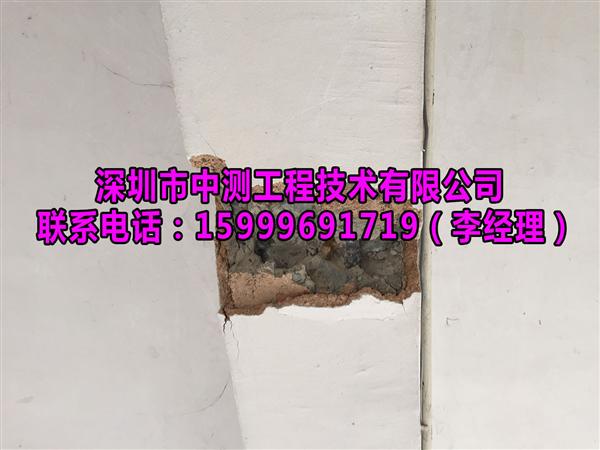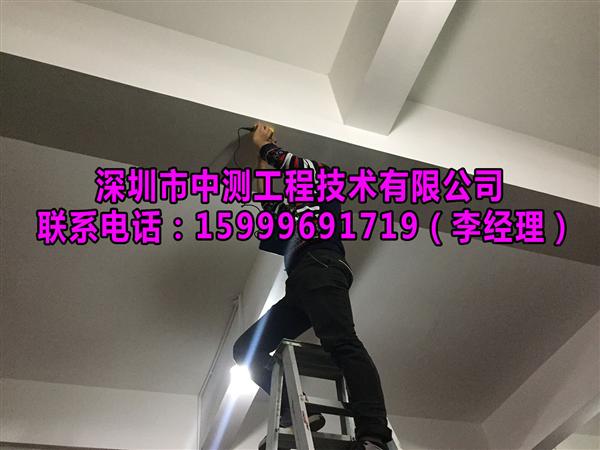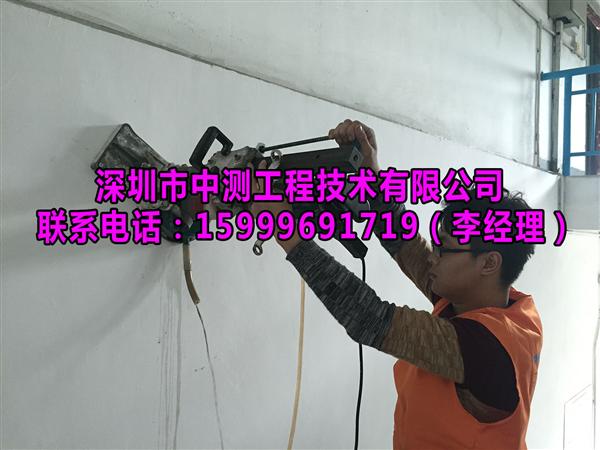Common housing crack safety testing and identification technology center:
Common housing crack safety testing and identification technology center, our company is an authoritative construction engineering quality testing company, with the national quality and technical supervision bureau measurement certification, China Construction Department qualification certification of the statutory testing institutions. The company's testing business covers professional fields such as foundation foundation, building materials, building structure, building seismic resistance, dangerous house identification, steel structure testing and reliability appraisal. The company has passed many measurement certifications and has the engineering quality inspection qualification certificate issued by the competent department of the industry. The quality inspection of construction projects has seven special inspection qualifications such as witness sampling, main structure, foundation foundation, municipal road, building doors and windows, steel structure and engineering quality appraisal. . The key to scientific and technological innovation lies in talents. The construction of scientific and technological talents is placed in the prominent position of scientific and technological work. The core of training, introducing and using high-level innovative scientific and technological talents is to cultivate innovative personnel training systems and mechanisms to create a good environment for talent growth and create a grand scale. Innovative scientific and technological talents with reasonable structure and high quality. The company will continue to do a good job in the evaluation and evaluation of internal experts, and give full play to the professional role of internal experts in related fields, encourage them to conduct research and technology research and development in frontiers in related fields, to build the core technical team of engineering and technology companies, Create an influential brand of engineering and technology experts. Professional handling of all types of factory inspection safety inspection and identification, plant structure safety testing and identification, plant quality and safety testing, plant crack safety testing, plant layering transformation testing, plant floor bearing testing and identification, plant damage safety testing and so on. Common housing crack safety testing and identification technology center, Shenzhen Zhongzheng Engineering Technology Co., Ltd. will serve you wholeheartedly, undertake the national business scope, provide free technical consulting services, contact telephone number, 15999691719 Manager Li 
First, the common housing crack safety testing and identification technology center - what are the common cracks:
Cracks are a kind of discontinuity of solid materials. The experience provided by a large number of engineering practices shows that cracks in buildings are inevitable, and the damage of houses often begins with cracks. Therefore, in the safety appraisal of houses, the identification and analysis of cracks is One of the important contents.
First, the main structural crack category
The house is subjected to two types of loads or effects during actual use: the first type of load, including static, dynamic and other loads; the second type of load, ie the deformation load (due to temperature changes, material shrinkage and expansion, foundation foundation Evenly settled, etc.). Therefore, cracks can be classified into load cracks and deformation cracks.
1, masonry structure crack
Load cracks are cracks in a wall caused by a first type of load. The wall bears its own weight and the vertical load from the floor and roof. The wall may also be subjected to horizontal earthquakes. When the stress caused by the load exceeds its compressive, shearing and tensile strength, it will be generated. Forced cracks.
A deformed crack is a crack caused by structural deformation. The external temperature, humidity change, foundation deformation and uneven settlement, and the shrinkage of the material itself may cause deformation of the building structure, causing large additional stresses in the brick wall. When the stress exceeds the material strength, It will cause cracking of the wall, that is, deformation cracks. Common deformation cracks include settlement cracks, temperature cracks, shrinkage cracks, and the like.
The investigation results at home and abroad show that the cracks generated by the masonry structure are about 90% of the deformation and deformation, and about 10% of the load or load.
2, concrete structure crack
Load crack: A crack caused by the stress generated by the direct action of the first type of load, called a load crack. When the structural self-weight, the use load and other factors exceed the initial set value of the design, the structural bearing capacity is less than the load, resulting in cracks in the structure. In the case of structural cracks caused directly by external loads, ordinary reinforced concrete members have cracks when the internal force reaches 30% ultimate load (concrete stress reaches tensile strength), and the crack width is 0.05-0.10 mm. Safety is generally unaffected and can withstand extreme loads of 70% to 80%. Therefore, the concrete structure allows the work with cracks, as long as it is safe to a certain extent or within the allowable width of the specification.
Deformed crack: A crack caused by a second type of load (deformation load). When the structure is deformed by the second type of load, and the deformation is not constrained to freely stretch, it will cause stress inside the structure. When the stress exceeds a certain value, it will cause cracks in the component. Under the action of deformation, the resistance and crack resistance of the structure depend on the tensile properties of the concrete, namely tensile strength and tensile deformation. In the engineering caused by deformation changes, the statically indeterminate structure is the majority. Because of the greater safety of the load-bearing capacity of such structures, it has better toughness and can adapt to larger deformations, sometimes even though the cracks are serious. The house will not collapse. According to statistics, such cracks in concrete structures account for more than 80% of all cracks, of which temperature and shrinkage cracks are mostly, followed by ground deformation cracks.

Second, the common housing crack safety testing and identification technology center - the relevant provisions of housing crack detection and identification:
1. The influence of crack on the structure and its severity should first be determined according to the macroscopic distribution of the crack on the structure or component. Combined with the corresponding documents and records, the inspectors can first make a preliminary assessment of the crack.
2. For unstable structural component cracks, in order to accurately grasp the trend of crack development from a macroscopic perspective, continuous observation must be carried out to make a correct judgment on the cause and severity of the crack.
3. The largest crack width and the largest crack change are generally the places where the stress is most concentrated. These parts are generally relatively weak structural members, and the safety hazards are relatively large.
4. The crack width is generally uneven along its length. The observation mark laid at the widest part of the crack is to determine the maximum value of the crack width; the observation mark laid at the end of the crack is to observe whether the crack continues to develop along the length direction.
5. If the crack observation period is too long, it is difficult to grasp the dynamic development of the crack and its danger to the structure. Only by accurately grasping the development trend of the crack can we reasonably judge its influence on the structure and make a correct decision, according to engineering experience. The crack observation period generally does not exceed one month.

Third, the common housing crack safety testing and identification technology center - the process and content of housing crack safety testing and identification:
(1) Review the building and structural drawings of the house, investigate the design and construction of the house in the early stage, and investigate the mix ratio of the materials, construction procedures, and demoulding time;
(2) Detection of the current status, position, width, depth and length of the crack;
For the detection of cracks in concrete structural members, including crack surface characteristics and crack depth. The surface features of the crack include the location of the crack, the number, the length, the direction of development, the starting point, the width of the surface of the crack, and the like. The method of visual inspection, tape measurement, and crack width inspection can be used to detect and record the crack position, width and length.
(3) Detection of the development trend of cracks (Gypsum can be used to seal the cracks, observe the change of gypsum and judge whether the crack development is stable);
(4) Floor deflection measurement;
Method 1: First, stand the leveling ruler on the upper flange of the beam or use a straight ruler to invert the measuring point of the lower edge of the beam. Read the reading with the water level meter, and then use the line connecting the measuring points at both ends of the beam as the baseline. The relative deformation of the measuring point in the middle of the beam. If you encounter support, you should increase the measurement point.
Method 2: Using the non-prism radiography total station instrument to directly test the upper flange edge measurement point or the lower flange edge measurement point, and then use the line connecting points at both ends of the beam as the baseline, and calculate the relative deformation of the middle measurement point of the beam. If you encounter support, you should increase the measurement point.
The deflection measurement of the horizontal member should be carried out by using a level gauge or a laser range finder. Three points of the component support and the span are selected as the measuring points, and the relative height difference between the component support and the span is measured, and the relative height difference is utilized. Calculate the deflection of the component. The beam deflection is measured using the Leica TCR1202 total station, and the sampling ratio is performed according to the minimum sample size of the building structure sampling test.
(5) Detecting the verticality of the wall
Because the verticality of the vertical member is an important indicator to measure the performance of the component, and it also affects the bearing capacity of the component (the influence of the secondary bending moment), it is necessary to measure the inclination of the column. The Leica TCR1202 can be used in the field. The total station is equipped with the steel ruler method to measure the inclination of the column, and the sampling ratio is performed according to the minimum sample capacity of the building structure sampling test.
(6) detecting the strength of concrete by rebound method;
The concrete beam, column, plate and other components are tested for concrete strength using non-destructive methods such as ultrasonic rebound method or rebound method. The number of samples of the same type of components should be no less than 10 (first with defective components). For the surface of the component with cement mortar layer, it needs to be cut into a size of 20cm × 20cm to expose the concrete surface, which is convenient for instrument detection.
When the concrete strength is comprehensively detected by the rebound method or the ultrasonic rebound method, if the test conditions are significantly different from the applicable conditions of the corresponding strength curve, the concrete core sample should be drilled for the compressive strength test method correction. The number of test pieces of each test unit core sample should be 3-6. For structural safety, the core is selected as much as possible for the core.
The concrete component is subjected to carbonization depth detection to detect whether the component concrete is carbonized. The concrete carbonation depth can be tested by spraying phenolphthalein or rainbow reagent. When the concrete carbonation depth detection and the rebound method are combined, the average value of the measurement points is taken as the representative value of the carbonization depth.
(7) Reviewing the arrangement of the steel bars of the main structural members;
The detection of the reinforcement of concrete members shall include the detection of the type, position, quantity and diameter of the steel bars. The detection of the reinforcement of the main force members shall be carried out by a combination of full census and key spot checks, using radar wave method or electricity. The magnetic induction method is used for non-destructive general survey, and the key parts are spot-checked by the method of chiseling concrete.
The thickness detection of the protective layer of concrete can be carried out by means of key sampling. The detection unit should be divided according to the type of the component, the working conditions, the damage condition and the quality of the concrete. The average value is taken as the representative value of the thickness of the protective layer according to the type of the member, but the minimum protective layer thickness should be given. The detection method can use the steel bar detector to detect the distribution and quantity of the thickness of the component protective layer. For the type and type of the steel bar, the concrete surface protection layer can be cut by the damage method. After the steel bar is exposed, the diameter of the steel bar is measured with a vernier caliper, and the steel bar is observed. model.
(8) Appearance defect detection;
Comprehensively detect the appearance defects of the components, such as: deformation, breakage, flashing, etc. Record in photo and text form. The test results can be recorded according to serious defects and general defects. For serious defects, the location and range of defects should also be recorded, so that the influence of defects can be considered in the calculation of resistance.
The detection of internal defects of concrete structural members, including the internal unconsolidated areas and holes, the construction joints formed by the secondary casting of concrete and the quality of the joints of the reinforcement and repair, the thickness of the surface damage layer, and the relative uniformity of various parts of the concrete.
(9) After the development of the crack is stable, consider the adverse effects of the crack on the structure, and carry out structural modeling calculation on the basement part to judge the safety of the house.
(10) Evaluation calculation
According to the actual data obtained from the test, the structural finite element model is established based on the actual effective section of the component, the crack condition and the actual deformation condition of the component, and the structure and components need to be evaluated.
In the structural safety assessment, the finite element method is used to check whether the hoist system meets the safety evaluation standard under each load combination, and the experience calculation time is analyzed by SAP2000 and Midas10.0 software, and the Ansys software is important for the structure. The node performs a fine finite element analysis.
According to the current national testing and appraisal standards and design specifications, the structural stress of the hoist is comprehensively evaluated. The safe components are determined according to the component stress ratio, the components with the stress ratio close to the limit, and the components with the stress ratio exceeding the specification, and the reinforcement is given. Reasonable advice. 
| About Glass Fiber Series Wire |
The insulation material uses 160 pieces /250 pieces non-alkali yarn glass fiber yarn, which is characterized by thin insulation layer, light weight and protective effect on inner insulation.Impregnating varnish used modified epoxy paint, epoxy, conforms to the ROHS certification, with excellent electrical properties and high mechanical and damp and hot resistance, suitable for ac, dc motor, synchronous generator, dry type transformer and high temperature electric appliance coil and winding, the high voltage ac motor, large dc motor, large wind turbines, glass envelope envelope particularly suited to 10 kv transformer and large and medium-sized high-voltage motor winding.
Glass Fiber Copper Wire
Name
Insulation Glass Fiber Winding Wire
Conductor
Copper
Dimension(mm)
Round: 1.0 ~ 7.0
Rectangular: Thickness(a): 1.0 ~ 10.0
Width(b): 3.0 ~ 35
Insulation Material Type
Fiber Glass
Insulation Thickness
Singer, double or according to your requirement
Standard
IEC; ISO9000; ISO9001; IATF16949
Packing
100kg ~120kg ply-wood spool (250*500)
Application
Oil-immersed transformer windings, medium
and large electrical motor and power substations, etc.
Glass Fiber Aluminium Wire
Name
Insulation Glass Fiber Winding Wire
Conductor
Aluminum
Dimension(mm)
Rectangular: Thickness(a): 1.0 ~10.0
Width(b): 3.0 ~ 35
Insulation Material Type
Fiber Glass
Insulation Thickness
Single, double or according to your requirement
Standard
IEC; ISO9000; ISO9001; IATF16949
Packing
50kg~150kg ply-wood spool (250*500/
250*550/ 250*600)
Application
Oil-immersed transformer windings, medium
and large electrical motor and power substations, etc.
Copper Flat Wire,Glass Fiber Series Wire,Double Glass-Fiber Copper Flat Wire,Fiberglass Copper Wire For Motor
HENAN HUAYANG ELECTRICAL TECHNOLOGY GROUP CO.,LTD , https://www.huaonwire.com